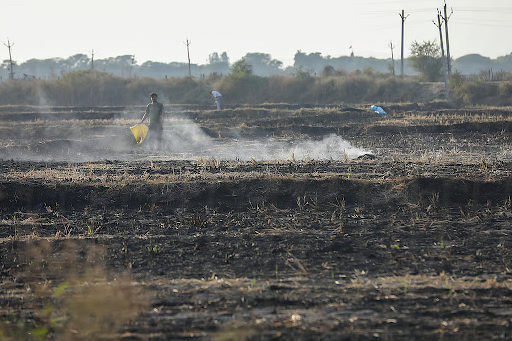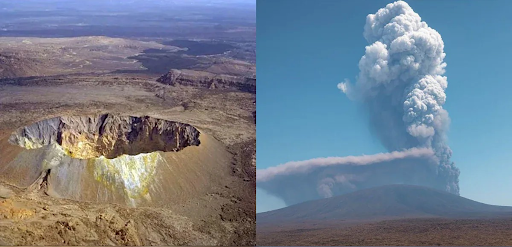



Madhya Pradesh has become India’s new stubble burning hotspot for a second year, accounting for nearly half of crop fire cases across northern states. Sheopur tops the national list, with seven MP districts in the worst ten, signaling a shift from Punjab-Haryana and demanding region-specific residue management.

Copyright infringement not intended
Picture Courtesy: DOWNTOEARTH
According to data from the Consortium for Research on Agroecosystem Monitoring and Modelling from Space (CREAMS) almost half of all crop-fire incidents observed in the northern states occurred in Madhya Pradesh.
|
Read all about: Stubble Burning in India: Causes, Impacts, and Solutions |
It is the practice of intentionally setting fire to crop residue after harvesting, which has become a major environmental and public health issue in India.
According to the Consortium for Research on Agroecosystem Monitoring and Modelling from Space (CREAMS) at the Indian Agricultural Research Institute (IARI), Madhya Pradesh alone accounted for nearly half of all incidents in 2025.
The decision to burn stubble is not a choice but a compulsion for many farmers, driven by a combination of economic, technological, and logistical challenges.
Economic Constraints
Alternative residue management (e.g., balers, mulchers) costs ₹2,500 to ₹3,000 per acre; financial burden for small and marginal farmers with narrow profit margins.
Technological Gaps
Despite government subsidies through the Crop Residue Management (CRM) scheme, the high upfront and operational costs of effective CRM machines like Happy Seeders and Super Seeders hinder individual farmer adoption.
Lack of a Viable Biomass Market
Underdeveloped crop residue market lacks assured procurement and remunerative prices for stubble, which is usable in bio-energy, Compressed Bio-Gas (CBG), and paper/packaging industries.
Time Pressure
Farmers have a narrow 10-20 day window between harvesting paddy/soybean and sowing wheat. Burning residue is the quickest, cheapest way to clear fields for the next crop.
Air Pollution: Farm fires release large quantities of harmful pollutants, including Particulate Matter (PM2.5 and PM10), Carbon Monoxide (CO), Methane (CH4), and Nitrous Oxide (N2O).
Soil Degradation: Burning crop residue harms topsoil by depleting nutrients and organic matter, killing microbes, reducing moisture, and degrading structure, resulting in long-term decreased agricultural productivity.
Public Health Crisis: High PM2.5 from stubble burning increases respiratory illnesses like asthma and bronchitis. The rural population, especially women and children, are most at risk.
Climate Change: Stubble burning emits greenhouse gases (CH4, N2O), directly contributing to global warming.
Strengthening the Bio-economy: Create a robust supply chain for biomass. This involves incentivising private companies to set up Compressed Bio-Gas (CBG) plants, ethanol refineries, and pelletisation units with guaranteed procurement from farmers at a fair price.
Improving Access to Technology: Instead of focusing solely on individual ownership, the government should promote Custom Hiring Centers (CHCs) and panchayat-level machine banks to make CRM equipment affordable and accessible to small farmers.
Crop Diversification: Promote alternatives to water-intensive paddy, especially in Punjab and Haryana, and encourage cropping patterns that generate less residue or have longer sowing windows.
In-situ Management: Scale up the use of microbial solutions like the Pusa Decomposer, developed by the Indian Agricultural Research Institute (IARI), which can break down stubble into manure in the field itself.
Policy Integration: Link stubble management with national goals like the National Clean Air Programme (NCAP) and climate commitments (Nationally Determined Contributions). States showing reduction in farm fires could be rewarded with climate finance or additional central grants.
The problem of stubble burning is a systemic issue requiring a robust policy framework that provides farmers with economic and technological alternatives to transform crop residue from a liability into an asset, thereby addressing air pollution, improving soil, meeting climate goals, and creating rural livelihoods.
Source: DOWNTOEARTH
|
PRACTICE QUESTION Q. With reference to the Commission for Air Quality Management (CAQM), consider the following statements: 1. It is a statutory body established under an Act of Parliament. 2. Its jurisdiction is limited to the National Capital Region of Delhi. 3. It has the power to impose Environmental Compensation for violations. Which of the statements given above is/are correct? A) 1 only B) 1 and 3 only C) 2 and 3 only D) 1, 2 and 3 Answer: B Explanation: Statement 1 is correct: The Commission for Air Quality Management (CAQM) is a statutory body established under the "Commission for Air Quality Management in National Capital Region and Adjoining Areas Act, 2021," passed by Parliament. Statement 2 is incorrect: The CAQM's jurisdiction is not limited to only the NCR of Delhi. Its full name, "Commission for Air Quality Management in the National Capital Region and Adjoining Areas," reflects its broader geographical scope. Statement 3 is correct: The CAQM has broad powers, including the authority to impose and collect Environmental Compensation (EC) for violations of its directions and air pollution control rules, such as stubble burning and construction and demolition activities. |
Madhya Pradesh is the new hotspot due to shifting cropping patterns, particularly the increased adoption of water-intensive paddy cultivation in districts like Sheopur, which yields more paddy straw. Low farm mechanization and inadequate government subsidies for Crop Residue Management (CRM) machinery make burning the cheapest option for farmers.
The CAQM is a statutory body established under the CAQM Act, 2021. Its primary role is to coordinate and implement plans to control air pollution in the National Capital Region (NCR) and its adjoining areas, which includes parts of Punjab, Haryana, Uttar Pradesh, and Rajasthan. It has powers of enforcement, including imposing fines and issuing directives to state governments.







© 2025 iasgyan. All right reserved